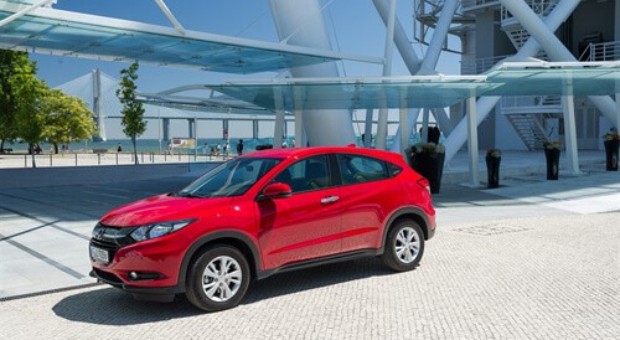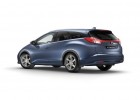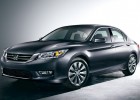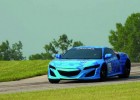
Introducing a new generation of subcompact SUV to the marketplace, the all-new Honda HR-V delivers a unique proposition to the crossover segment: stylish coupé looks with the tough stance of an SUV, the space and versatility of an MPV, sophisticated-yet-fun driving dynamics and fuel-efficient performance.
Honda anticipates 70% of new HR-V customers will be conquest buyers from other brands, predominantly from the MPV and C-segment. The 4.3-metre long HR-V is designed to appeal to young singles and pre-family couples who value their lifestyles and are design conscious.
From the first glance, the new HR-V portrays a characterful youthfulness; the distinctive, boldly-sculpted lines of a coupé merged with a robust SUV. The taller stature, combined with a solid design and strong presence, provides a feeling of safety, security and confidence.
Inside, the new HR-V offers occupants class-leading interior space and – thanks to Honda’s innovative Magic Seat® system – high levels of versatility. High quality soft-touch materials and sophisticated design define the HR-V’s interior where Honda’s designers have married expansive spaciousness with the feel of a sporty, enclosed cockpit.
The new HR-V will be available with a choice of highly efficient 120PS 1.6 litre i-DTEC diesel or 130PS 1.5 litre i-VTEC petrol engines, both part of Honda’s Earth Dreams Technology series. The diesel has a six-speed manual while the petrol has a six-speed manual or CVT.
The new HR-V is part of the wave of next-generation and all-new vehicles from Honda, demonstrating the brand’s pioneering approach to technological innovation which makes life better for its customers. Honda’s all-new HR-V line-up, which will feature a choice of three equipment grades, will go on sale in the UK in late summer.
For Honda’s design team, the all-new HR-V’s design concept was summarised as ‘Dynamic Cross Solid’. The concept was to combine the elegance and fluidity of a coupé with the utility and strength of an SUV.
“Combining a high eye-point and toughness – core values of an SUV – with a new level of emotion was the key,” says Masaki Kobayashi, HR-V styling project leader. “So we came up with an exterior concept encapsulated by ’Emotionality and Toughness’ and an interior concept called ’Personal Cockpit and Expansiveness’. We wanted to fuse apparently conflicting values to create something fresh.”
The all-new HR-V is a product borne of the determination to offer something fresh and innovative but with the real lives of real people and families at its core. The HR-V has a coupé-like cabin profile, with a powerful nose and strong lower body forms, together with finely sculpted surface detailing – creating a characterful look that will produce an emotional appeal among a target audience which highly values style and practicality.
On the road, the new HR-V boasts a distinctive and self-assured identity, while having a clear family lineage, leading with a ‘solid wing face’ nose design. The front grille is black, representing toughness and fearlessness.
HR-V’s coupé-like body shape creates a dynamic and sporty look, complemented by rear door handles ‘hidden’ in the C-pillar. Distinctive, sharply defined lines run the length of the body, giving the HR-V a purposeful, forward-leaning stance and a sense of movement and agility, even at standstill.
Honda’s designers paid attention to ensuring the new HR-V also exudes a reassuringly robust presence. Deeply sculpted lower body panels and the strong horizontal orientation of the front and rear bumpers convey the toughness, solidity and sure-footedness associated with larger SUVs.
A new class-leading aerodynamic performance is brought to the crossover segment by new HR-V. Beneath the vehicle, three covers (under the engine, front floor and rear floor) help to smooth and optimise air-flow, boosting fuel efficiency. They also enhance noise insulation for improved interior refinement. Aerodynamic development work focused on optimising front and rear aerodynamic lift to further improve vehicle stability at speed.
Kobayashi adds: “For the exterior we are very pleased with its dynamic shape, the high quality of the surfaces and the intricate but seamless detailing. I can say that when the whole team first saw the prototype vehicle together, we felt proud and special that we were able to realise our targets with this new car. I believe that the HR-V possesses the elegance to look attractive in any scene and yet exudes toughness at the same time.”
The all-new HR-V will be available from launch in four metallic (Brilliant Sporty Blue, Alabaster Silver, Modern Steel, Ruse Black) and three pearlescent (Morpho Blue, Crystal Black, White Orchid) paint finishes, as well as solid Milano Red. The newly-introduced Ruse Black and Morpho Blue are available exclusively for the new HR-V.
The aim of Honda’s designers was to balance class-leading interior space, ease of use and storage space with dynamic and emotional design. In order to achieve this, the space and layout of the HR-V was determined ahead of Honda’s designers bringing the overall concept to life. Accordingly, HR-V boasts an interior packed with functionality but also with a sense of personal space and fun. Roomy and incredibly versatile, the HR-V’s cabin brings the virtues of an MPV into the crossover segment for the first time while providing a driving position which engenders a sense of agility and dynamism.
HR-V owners will enjoy a feeling of security and confidence when driving thanks to an eye-line 100 mm higher than the average sedan or wagon, together with a wide field of vision. The raised floor and correspondingly higher seating position contribute to improved cabin access.
The foundation of the HR-V’s spacious and versatile interior is Honda’s centre-mounted fuel tank layout. This space-efficient innovative packaging mounts the low profile fuel tank under the front seats, which frees up the underfloor space beneath the rear seats. This enables the platform to accommodate Honda’s Magic Seat system, a popular feature on many models in the Honda range.
The Magic Seat system allows each of the 60:40 split second-row seats to adopt numerous configurations to maximise the people and load carrying versatility of the cavernous interior. The Magic Seat system can adopt one of three ‘modes’ from the standard seating position.
Utility mode – the rear seat back folds forward as the seat base itself lowers into the rear passenger footwell, creating a maximum 1,845 mm-long flat floor.
Tall mode – the front of the rear seat base rises up and back and is locked in a vertical position to leave a cargo height of 1,240 mm from floor to ceiling, allowing tall objects to be placed behind the front seats.
Long mode – the front passenger seat back folds back to a horizontal position, while the rear seat back folds forward, forming a ‘tunnel’ to accommodate items up to 2,445 mm long.
Occupants will appreciate the class-leading cabin space, with headroom, legroom and shoulder room in the front and rear so generous that they match the dimensions more commonly found in larger vehicles.
The cargo bay also offers impressive space, challenging for best-in-class honours with a capacity of 453 litres with the rear seats upright, increasing to 1,026 litres with the rear seats folded. The new HR-V’s wide tailgate opening (1,180 mm) and low loading height (650 mm) ensure that the capacious cargo space is easily accessible.
Travelling long distances in the new HR-V will be a comfortable and fatigue-free experience for the driver and passengers thanks to Honda engineers’ determination to provide this model with class-best levels of refinement.
A new, highly efficient acoustic insulation package was developed for the new HR-V, featuring a top quality, non-woven underlay and sound-absorbing carpets of a type usually found only in high-grade sedans. The front and rear inner wheel arches have been treated with sound-absorbent material, while the floor carpet, underfloor cover and dashboard acoustic pad inserts all contribute to achieving a refined and relaxing atmosphere throughout the cabin. At a constant speed of 62mph, occupants can enjoy a whisper-quiet 65 dB of cabin noise.
Honda’s designers sought to marry conflicting themes in the new HR-V’s interior, striving to achieve spaciousness, reassuring solidity and – for the driver – a cockpit with the wraparound feel of a coupé.
The expansive, airy cabin is fitted with high quality, soft-touch surfaces, subtly accented with brushed chrome highlights and sophisticated stitching lines to provide a premium ambience. The dashboard design combines a solid feel with premium detailing, including a piano-black feature panel that emphasises the sense of quality, class and refinement.
Sensual colour and texture coordination options will enable customers to express their youth, intelligence and maturity through their personal choices while giving the new HR-V’s interior a feeling of high fashion.
Facing the driver, a three-dial instrument binnacle features ‘floating’ illumination rings and Honda’s ECO Assist function, which changes the backlight colour of the speedometer from white to green during fuel-efficient driving.
Facing the front seat passenger, the new HR-V’s interior features a new ‘wide flow’ air outlet with three adjustable air vents across the dashboard, resulting in a comfortable airflow for all passengers. The air flow volume settings are optimised to deliver: high volume for the outlet nearest the side window; low volume for the centre outlet; and medium volume for the air outlet closest to the centre panel.
The new HR-V will be available in three grades. Depending on the grade and market, buyers will have a choice of high quality fabric, half-leather or full-leather upholstery, each in a classic black finish. The sense of spaciousness is amplified on top grade models in the new HR-V line-up by the availability of a unique-in-class opening panoramic glass sunroof. With one-touch opening tilt and slide operation, the 846 mm-long panoramic sunroof features a sliding sunshade that opens automatically with the roof and can be closed manually to block sunlight. The front section – which tilts to a height of 27.5 mm at its rear – measures 475 mm in length.
Honda’s new ‘Smart Touch Interior’ will enable operation of certain functions with the smallest movement and effort. These functions include: Electric Park Brake, Touch Panel Climate Control and One-Touch Indicator.
Advanced connectivity and infotainment is provided in the all-new HR-V by the Honda CONNECT in-car infotainment system, first seen in Europe on the 2015 CR-V. It is fitted as standard on the mid and upper grade HR-V, and as an option on the base model.
Honda CONNECT has an app-based user interface with ‘pinch, swipe and tap’ functionality identical to that of a modern smartphone. Running on Android, the world’s most popular mobile operating system, Honda CONNECT gives fast access to internet-based services.
The Honda CONNECT system comes with pre-installed apps, with others available for download from the Honda App Centre for owners to personalise their connected experience. The pre-installed ‘Aha’ app allows effortless access to thousands of audio stations – spanning music, news, podcasts and audio books – as well as social media feeds and location-based services.
Easy and intuitive to use, the system is accessed through a seven-inch touchscreen in the centre of the dash. The display can be customised to suit individual preferences, with two different ‘skins‘ to choose from, allowing users to make the system their own. Colour-coded icons ensure navigating through menus is quick and simple.
The Honda CONNECT touchscreen also displays vehicle information – such as trip information and fuel economy – and images from the rear-view parking camera (depending on model).
In addition, the Honda CONNECT system features extensive options for syncing with smartphones and other personal multimedia devices: WiFi, Bluetooth, HDMI, and MirrorLink – which ‘mirrors’ the screen of a connected compatible device, allowing it to be operated through the in-dash touchscreen.
Also available as standard on the upper grade and as an option across the range, Honda offers HR-V buyers the award-winning Garmin satellite navigation system. The system is fully integrated with Honda CONNECT and packed with pre-loaded maps, allowing navigation without mobile data reception.
Spoken turn-by-turn directions are complemented by advanced guidance features, while photo-real junction views make it easier to identify selected junctions and exits. The system also features real-time traffic avoidance, speed limit indications, lane guidance, sign-view, 3D building and terrain views, and Eco Routing. Free map updates will be provided for four years, a benefit unique to Honda.
HR-V base models are fitted as standard with a five-inch LCD colour display screen in the centre of the dash and a 160-watt AM/FM/CD Audio system with four speakers. Mid and upper grade models are fitted with a 180-watt six-speaker audio system.
With this 1,498 cc petrol engine, the new HR-V powers from 0- 62 mph in 10.7 seconds (manual) and 11.2 seconds (CVT ). Fuel economy can be up to an impressive 54.3mpg (combined cycle) with CO2 emissions from as low as 120 g/km – both achieved using CVT.
The 1.6 litre i-DTEC engine is unique to Honda vehicles on sale in Europe. The common rail turbo-diesel unit incorporates extensive technologies that reduce friction, improve emissions and increase fuel economy. The 1,597cc engine features a small, high-efficiency turbocharger, low-pressure EGR (exhaust gas recirculation) system and a high-intake flow, high-swirl cylinder head port. A new high-strength, lightweight slender crankshaft and all-aluminium, open-deck, high-pressure, die-cast engine block reduce the engine’s weight.
Powered by the diesel engine – which generates 120 PS at 4,000 rpm and 300 Nm of torque at 2,000 rpm – the new HR-V can accelerate to 62 mph in just 10.0 seconds, placing it among the most dynamic vehicles in its class. With manual transmission, fuel economy is an impressive 74.3mpg (combined cycle) with CO2 emissions of 104 g/km.
Both the petrol and diesel engines are equipped with a six-speed manual transmission as standard, featuring several improvements for their application in the new HR-V. Optimisation of the physical gear width and layout arrangement allowed engineers to shorten the gearbox, while a lightweight and higher-rigidity shaft improves overall efficiency. The feel and quality of the gear shift is enhanced, improving the oblique shift operation and achieving a smoother, one-movement shift pattern. The effort required to engage reverse gear is reduced and the gear noise when driving in reverse is minimised.
Honda’s popular optional CVT (also available in the forthcoming 2015 Jazz) is available with the 1.5 litre i-VTEC petrol engine. An all-new CVT control logic was developed for the UK market to deliver the direct and linear feeling expected of a manual transmission. This results in vehicle speed matching accelerator pedal position closely for a direct feel, while engine speed increases proportionately to accelerator pedal position for a more linear feel.
The CVT’s driveability is given a more natural ‘multi-gear’ feel through new control software exclusive to Europe which simulates seven speeds and provides optimised gear change mapping. Two new additional programmes provide situation-specific enhancements.
Early Downshift During Braking (EDDB) utilises the engine to assist the driver during braking. When the system recognises a deceleration, downhill, or cornering situation initiated by the braking system, EDDB automatically increases the engine speed to provide engine braking. This then allows for quick re-acceleration after slowing or quick acceleration after cornering.
Fast Off measures how quickly the driver releases the accelerator pedal and maintains engine revs to provide engine braking in situations where the driver has released the pedal quickly. This system has been extensively tested for Europe’s high speed, multi-lane roads. For example, Fast Off recognises when the driver has prepared to pass a vehicle in front, but is unable to complete the manoeuvre due to a vehicle in the next lane. As the driver quickly releases the accelerator pedal to let the vehicle behind pass by, Fast Off maintains a high engine speed in preparation for completing the overtaking manoeuvre.
This newly-developed CVT unit delivers impressive fuel economy in conjuction with these significant improvements to driveability. The CVT gearbox allows the engine to operate within its most efficient range more of the time by continuously varying the gear ratio instead of adjusting the engine throttle opening. Automatically managed by the engine management system, the CVT gearbox selects the optimal ratio within the simulated seven speeds depending on engine speed, throttle position and driver input. Economy is boosted further by the transmission’s wider ratio range and reduced weight, the result of a rationalised design with reduced pulley pressure. Reductions in friction have been achieved through an optimised oil pump capacity, reduced oil resistance, a low friction reverse brake and a reduced friction from the rotational sliding parts.
The HR-V is one of the global compact series that Honda has developed to deliver a sophisticated, fun, sedan-like experience, while also engendering a feeling of security.
The platform and bodyshell of the new HR-V form a highly rigid structure, with 27% of the body made of high-strength steel and featuring improved frame joint rigidity. The stiff bodyshell gives the suspension (MacPherson struts at the front and an H-type torsion beam at the rear) a solid foundation, which – together with a low centre of gravity and minimised body roll – delivers a reassuring solidity and inspires a feeling of security when driving.
The feeling of agility is augmented by a new motion adaptive electric power-assisted steering system with a brushless motor. To minimise understeer, the front suspension features a lower front roll centre to enhance stability and the rear suspension has a raised roll centre. The result is exceptionally linear driving behaviour making new HR-V one of the most confidence-inspiring crossovers, especially when driven enthusiastically.
Powerful and stable stopping power for the new HR-V is assured with an all-disc braking system, featuring 293 mm ventilated front discs and 282 mm solid discs at the rear. Electronic aids which boost braking power and enhance vehicle stability include: Anti-Lock Braking System (ABS), Electronic Brakeforce Distribution (EBD), Brake Assist, Vehicle Stablity Assist and Hill Start Assist.
Every new HR-V in Europe is fitted with alloy wheels. base and mid grades feature 16-inch wheels with 215/60 R16 tyres, while upper specification models are equipped with 17-inch wheels shod with 215/55 R17 tyres.
New Advanced Compatibility Engineering targets five-star safety ratingAs with all new Honda vehicles sold in Europe, the HR-V is fitted with a wide range of active and passive safety technologies designed to make driving both easier and safer, while maximising occupant and pedestrian protection.
Every new HR-V sold in Europe will be equipped with Honda’s City-Brake Active System. Specifically designed to help avoid or mitigate low speed accidents, the system uses laser radar technology to scan the road ahead, automatically applying the brakes if an imminent risk of collision is detected. The system is designed to operate at speeds below 20 mph. If the system identifies a risk of collision then pre-braking as well as audible and visual warning will occur, eventually followed by full autonomous braking to bring the car to a stop.
Mid and upper grade models will feature Honda’s Advanced Driver Assist System, which uses radar sensors, plus forward and rear facing cameras, as standard. This comprehensive suite of active safety technologies includes: Forward Collision Warning, Traffic Sign Recognition, Intelligent Speed Limiter, Lane Departure Warning and High-beam Support System.
Four-door, five-seat SUV with unitary construction bodyshell. A choice of two engines and two transmissions driving the front wheels.
| Engine | |||||||
| 1.6 litre i-DTEC (diesel) | 1.5 litre i-VTEC (petrol) | ||||||
| Type | 4 valves per cylinder | 4 valves per cylinder | |||||
| Capacity (cc) | 1,597 | 1,498 | |||||
| Bore x stroke (mm) | 76.0 x 88.0 | 73.0 X 89.5 | |||||
| Compression ratio | 16.0 | 11.5 | |||||
| Power | 120 PS at 4,000 rpm | 130 PS at 6,600 rpm | |||||
| Torque | 300 Nm at 2,000 rpm | 155 Nm at 4,600 rpm | |||||
| Transmission | |||||||
| 1.6 litre i-DTEC (diesel) | 1.5 litre i-VTEC (petrol) | ||||||
| Manual | 6 speeds | 6 speeds | |||||
| CVT | – | Variable with 7 simulated ‘gears’ | |||||
| Gear ratios | |||||||
| 1.6 litre i-DTEC 6 speed manual | 1.5-litre i-VTEC 6 speed manual | 1.5-litre i-VTEC CVT (simulated gears) | |||||
| 1st | 3.642 | 3.642 | 2.526 | ||||
| 2nd | 1.884 | 2.080 | 1.573 | ||||
| 3rd | 1.179 | 1.361 | 1.211 | ||||
| 4th | 0.869 | 1.023 | 0.944 | ||||
| 5th | 0.705 | 0.829 | 0.755 | ||||
| 6th | 0.592 | 0.686 | 0.603 | ||||
| 7th | - | - | 0.408 | ||||
| Reverse | 3.673 | 3.673 | 5.822 | ||||
| Final Drive | 3.850 | 4.705 | 5.436 | ||||
| Suspension and damping | |||||||
| Front | MacPherson Strut | ||||||
| Rear | H-type torsion beam | ||||||
| Steering | |||||||
| 1.6 litre i-DTEC (diesel) | 1.5 litre i-VTEC (petrol) | ||||||
| Type | Rack and pinion | ||||||
| Steering turns (lock to lock) | 2.71 | 2.79 | |||||
| Turning circle (at wheels) | 10.6 | ||||||
| Turning circle (at body) | 11.4 | ||||||
| Brakes | |||||||
| Front | 293 mm ventilated disc | ||||||
| Rear | 282 mm disc | ||||||
| Wheels and tyres | |||||||
| Wheel size | Tyres – Front | Tyres – Rear | |||||
| x 16-inch | 215 | 60R16 | |||||
| x 17-inch | 215 | 55R17 | |||||
| Dimensions (mm) | |||||||
| Exterior | (mm) | ||||||
| Overall length | 4,294 | ||||||
| Overall width | 2,019 (including door mirrors) | ||||||
| Overall height | 1,605 (including antenna) | ||||||
| Wheelbase | 2,610 | ||||||
| Capacities (litres) | |||||||
| Luggage | 453 (seats up) / 1,026 (seats folded) | ||||||
| Fuel tank | 50 | ||||||
| Weights (kg) | |||||||
| Engine | 1.6 litre i-DTEC 6-speed manual | 1.5 litre i-VTEC 6-speed manual | 1.5 litre i-VTEC CVT | ||||
| Kerb weight (inc 100% fuel) | 1,324 – 1,404 | 1,241 – 1,313 | 1,249 – 1,322 | ||||
| Performance and fuel consumption | |||||||
| Engine | 1.6 litre i-DTEC 6-speed manual | 1.5 litre i-VTEC 6-speed manual | 1.5 litre i-VTEC CVT | ||||
| Maximum speed (mph) | 119.3 | 119.3 | 116.2 | ||||
| 0-62mph (seconds) | 10.1 | 10.7 | 11.2 | ||||
| Fuel consumption urban (mpg) | 67.3 (16” wheels) 64.2 (17”) | 40.4 (16”) 39.8 (17”) | 46.3 (16”) 44.8 (17”) | ||||
| Fuel consumption extra urban (mpg) | 74.3 (16”) 72.4 (17”) | 58.9 (16”) 57.6 (17”) | 61.4 (16”) 58.9 (17”) | ||||
| Fuel consumption combined (mpg) | 70.6 (16”) 68.9 (17”) | 50.4 (16”) 49.6 (17”) | 54.3 (16”) 52.3 (17”) | ||||
| CO2 combined (g/km) | 104 (16”) 108 (17”) | 130 (16”) 134 (17”) | 120 (16”) 125 (17”) | ||||




















